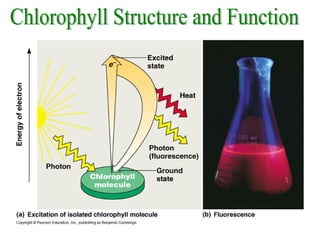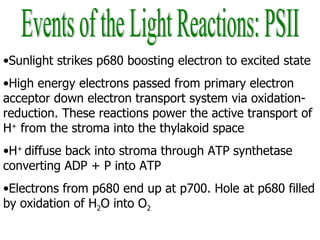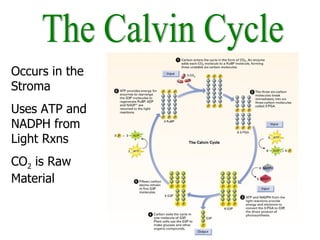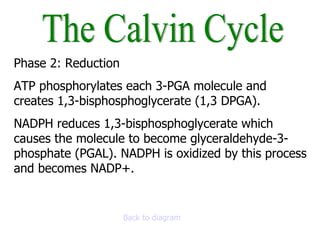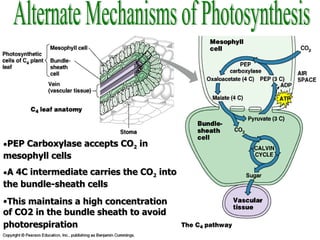Photosynthesis
- 1. The Biology of Photosynthesis
- 2. An Overview of Photosynthesis This presentation will focus on: The importance of autotrophs An overview of photosynthesis Leaf and chloroplast structure and function The electromagnetic spectrum Pigment function and variety The Light Reactions The Calvin Cycle
- 3. The Importance of Autotrophs
- 4. The Importance of Autotrophs
- 5. The Importance of Autotrophs All organisms require a source of energy All organisms require a source of carbon compounds Provides molecular oxygen for the atmosphere
- 6. The Importance of Autotrophs 2 Types of Autotrophs: Chemotrophs Photoautotrophs
- 7. An Overview of Photosynthesis 6 CO 2 + 6 H 2 O C 6 H 12 O 6 + 6 O 2
- 8. An Overview of Photosynthesis
- 9. Leaf Structure and Function Plants are composed of three major organ systems: The Root System anchors the plant in place stores excess sugars absorbs water and mineral nutrients The Shoot System supports the plant body provides passageway for nutrients and minerals Leaves site of photosynthesis (food production)
- 10. Leaf Structure and Function Plant organs are made up of 3 types of tissues: Dermal cells for structure and protection secretion of cutin to prevent water loss Ground photosynthesis storage of food and water Vascular specialized for transport of water and nutrients
- 11. Leaf Structure and Function
- 12. Leaf Structure and Function
- 13. Leaf Structure and Function
- 14. Chloroplast Structure and Function
- 15. The Electromagnetic Spectrum The ultimate source of energy is the sun Solar energy is called electromagnetic radiation Travels in waves of photons The Electromagnetic spectrum describes the range of energy in solar radiation The EM spectrum is measured by wavelength
- 17. Pigments Pigments are organic molecules that absorb visible light Wavelengths not absorbed are reflected, creating the visible color of an object Wavelengths absorbed cause the excitations of electrons Plants contain a major pigment, chlorophyll a, and accessory pigments like carotenoids and anthocyanins
- 18. Pigments
- 19. Chlorophyll Structure and Function
- 20. Chlorophyll Structure and Function
- 21. Review of Major Concepts So Far! Go to http://www.wiley.com/legacy/college/boyer/0470003790/animations/photosynthesis/photosynthesis.htm Go through the sections called “Overview” and “Strategy/Players”
- 22. The Reactions of Photosynthesis The Light Reactions Light Dependent “ Photo” Division Energy Capturing The Calvin Cycle Light Independent “ Synthesis” Division Energy Storage
- 23. The Light Reactions Occur on thylakoid membranes Use 2 Photosystems PSI (p700) and PSII (p680)
- 24. Chlorophyll Structure and Function
- 25. Click image to see a membrane view of the light reactions
- 26. Events of the Light Reactions: PSII Sunlight strikes p680 boosting electron to excited state High energy electrons passed from primary electron acceptor down electron transport system via oxidation-reduction. These reactions power the active transport of H + from the stroma into the thylakoid space H + diffuse back into stroma through ATP synthetase converting ADP + P into ATP Electrons from p680 end up at p700. Hole at p680 filled by oxidation of H 2 O into O 2
- 27. Events of the Light Reactions: PSI Sunlight hits p700 boosting electron to excited state High energy electrons passed from primary electron acceptor down electron transport system via oxidation-reduction. High energy electrons transferred by NADP + reductase to NADP + to form NADPH Hole at p700 filled by electrons from p680
- 28. Click image for link to animated overview of noncyclic photophosphorylation
- 29. Light Reactions Summary Sunlight + H 2 O O 2 + ATP + NADPH ADP, P, and NADP + from Inorganic Nutrient Pool are raw materials Study the following tutorials: You control the light reactions! Biology Project Light RXNs Tutorial Photosynthesis Light RXNs Interactive
- 30. The Calvin Cycle Occurs in the Stroma Uses ATP and NADPH from Light Rxns CO 2 is Raw Material
- 31. . . .
- 32. The Calvin Cycle Phase 1: Carbon Fixation CO 2 comes into the stroma of the chloroplast via the stomata of the leaves. Rubisco catalyzes the bonding of CO 2 to RuBP to create an unstable 6-carbon molecule that instantly splits into two 3-carbon molecules of 3-PGA. Back to diagram
- 33. The Calvin Cycle Phase 2: Reduction ATP phosphorylates each 3-PGA molecule and creates 1,3-bisphosphoglycerate (1,3 DPGA). NADPH reduces 1,3-bisphosphoglycerate which causes the molecule to become glyceraldehyde-3-phosphate (PGAL). NADPH is oxidized by this process and becomes NADP+. Back to diagram
- 34. The Calvin Cycle Phase 3: Regeneration For every six molecules of PGAL created, five molecules continue on to phase 3 while one leaves to be used for organic compounds. ATP is once again needed. However, this time it phosphorylates G3P to regenerate RuBP after some rearrangement. Back to diagram
- 35. The Calvin Cycle Summary of Calvin Cycle CO 2 + ATP + NADPH ADP + NADP + + PGAL PGAL is rearranged to produce: Glucose for cellular respiration Fructose in Fruits Sucrose for Transport Throughout Plant Starch for Storage Study the following tutorials: The 3 Phases Animated Calvin Cycle Tutorial at Biology Project Photosynthesis Dark RXNs Interactive
- 36. Alternate Mechanisms of Photosynthesis Plants fight water loss and dehydration Close stoma to prevent water loss Closed stoma mean no input of CO 2 into leaf Light reactions continue to produce O 2 Photorespiration When O 2 concentration increases, rubisco adds O 2 to the Calvin Cycle instead of CO 2
- 37. Alternate Mechanisms of Photosynthesis Photorespiration Occurs on bright, hot, dry days when stoma close Consumes O 2 Releases CO 2 Unlike cellular respiration, generates no ATP Unlike photosynthesis, generates no food Actually decrease rate of photosynthetic output
- 38. Alternate Mechanisms of Photosynthesis Mechanisms to fight photorespiration: C4 and CAM pathways Incorporate CO 2 into organic acids first, then release it into the Calvin Cycle
- 39. Alternate Mechanisms of Photosynthesis PEP Carboxylase accepts CO 2 in mesophyll cells A 4C intermediate carries the CO 2 into the bundle-sheath cells This maintains a high concentration of CO2 in the bundle sheath to avoid photorespiration



















